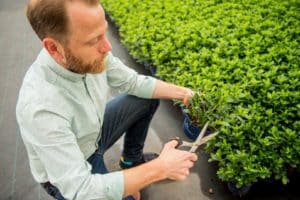BLOG: grower report Floramor
This report all started with a drive to Belgium, the birthplace of azalea floriculture, and home to Azalea grower FlorAmor. Christoph Stevens is my enthusiastic guide during the special visit to the Ghent region that follows.
Why is Belgium traditionally the epicentre of the azalea world?
This plant originated in East Asia. In the late 18th century, explorers brought back beautiful plants from their far-off journeys for the local aristocracy, who competed with each other in flaunting their collections of exotic plants. The azalea really caught the eye thanks to its wealth of flowers. The plant quickly became popular, and it turned out that the region around the rich city of Ghent was perfect for cultivating the plant. It enjoys a moderate sea climate, and the wide sand ridge in the area provides the ideal soil.
Azaleas have been grown here for over 200 years, so knowledge about them is interwoven in our society. That includes me, as I’ve been visiting and working at the nursery since I was a child. It’s therefore no surprise that the vast majority of azaleas come from this region.
How might customers know FlorAmor?
Indoor azaleas are our main crop. We place our proven standard varieties on the market under the name ‘Flandresse‘ and our special, innovative varieties under the name ‘Hortinno‘. We also grow a number of other plants, including Rhododendron and Clivia. The name of our nursery is fairly new, a result of the merger of two nurseries in 2018.
How did that happen?
We are both highly specialised azalea growers, and we cooperated with each other regularly. Thanks to this merger, it’s much more efficient for us to make the investments required to make our company more sustainable. It benefits our customers because they have access to the complete azalea range, and we can handle all their orders, whether large or small.
What challenges do you face in growing a good azalea?
It’s a sensitive plant to grow, but the right amount of effort and care delivers strong plants. We have a number of cultivation sites, and all our crop managers have plenty of experience. Together, we make sure the right conditions are in place all the time, because it’s virtually impossible to correct any mistakes during breeding. The biggest challenge, however, is the time these plants take to grow. The azaleas we supply are 2 to 3 years old, so the decisions we make in terms of the range are only visible years later.
What is your relationship with Javado?
In the past, we used Belgian traders to sell our stock. In the late 1990s, I realised that I could reach all of Europe through the network of Dutch exporters, so I drove north with some plant samples. Javado was my first stop. They were happy to talk to this young Belgian, and we clicked immediately. I’m still very pleased with the way they pay attention to their suppliers, and the click is still there.

Everything we grow comes from our own cuttings. First, the azalea is topped several times during cultivation. This results in well-branched plants with lots of flowers. The parts we remove are used as cuttings for our future plants. These are planted in pots, where they take root. We make sure the soil is very wet, and cover the pots with foil. This creates a climate with 100% humidity. Once roots have developed, we remove the foil. During the last year of the cultivation, the plants are place outside, because Azaleas need to be stimulated by cold to develop flowers.
What can we expect from you in the future?
Together with the breeder who works exclusively for us, we’re developing some really beautiful varieties. These are more resilient, so they can be grown in a more sustainable way, and can also withstand conditions indoors and in the store more easily. We’re also developing new flower and leaf shapes, and innovative colours.
The Kinku Saku is a new series, and features beautiful spider flowers. Patience is needed to scale up new species to create larger quantities. Next spring, we’ll finally be ready to supply a nice batch of this product.
Published on: 18 December 2019